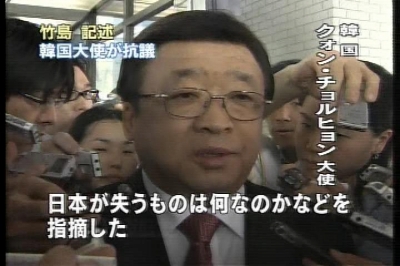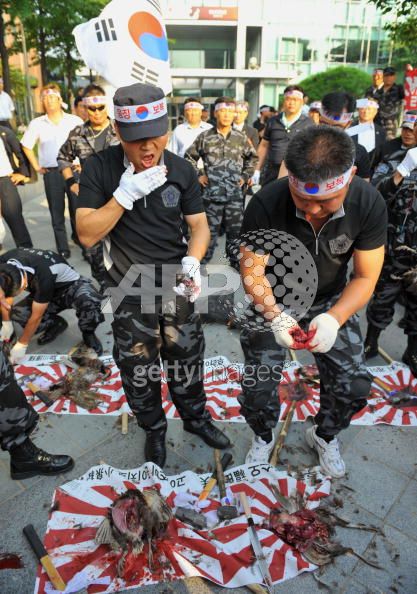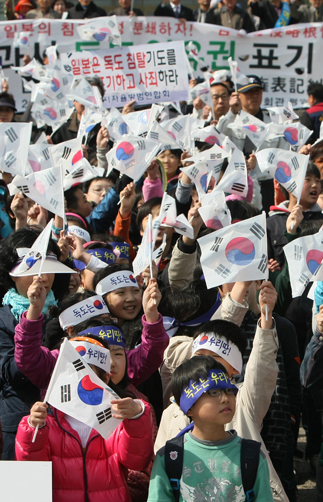According to the article of JoongAng Daily,
South Korea took a more aggressive stance yesterday against Japan’s claim over Dokdo as President Lee Myung-bak expressed an intention to bolster Seoul’s “effective control” of the islets and the legislature adopted a resolution to denounce Tokyo’s latest move.
and also,
The National Assembly approved yesterday a resolution to condemn Japan’s latest claim. Lawmakers demanded through the resolution that the Japanese government withdraw its authorization of the controversial textbooks. They also warned that Tokyo’s continuous claim will seriously hinder friendship between Korea and Japan.
"hinder friendship"? How so? This is Korean way of intimidating Japan, I believe. If Korean really need some kind of friendship with Japan, it is necessary for them to admit that Japanese also has own opinion on their territory, even if it antagonizes Korea's view. True friendship means accepting the differences of each other.
In 2008, South Korea briefly recalled its ambassador to Japan after guidelines for Japanese junior high school teachers guided to teach Takeshima as Japan's territory, just like northern territory, in the classroom. He left with a parting shot "Japan would lose something very important", but soon sneaked back to Japan. Korean protesters decapitated pheasants In 2005, chopped off their own fingers outside the Japanese embassy following Shimane prefecture’s decision to label the 100th anniversary of Japan’s annexation of the islets “Takeshima Day”.


This time, there's no wacky acts like chopping parts of the body by Korean citizens, except for this.

Are they burning Japanese textbook and "Dokdo" as well? What the ...? I wouldn't say all the Korean are, but at least the guys dressed in Korean national flag in this photo are total moron.
Update:
 Looks like it wasn't only the eccentric guys, but so many other Koreans joined this kind of silly acts all around Korea. Korean should stop brainwashing and using their own kids for this silly performances immediately.
Looks like it wasn't only the eccentric guys, but so many other Koreans joined this kind of silly acts all around Korea. Korean should stop brainwashing and using their own kids for this silly performances immediately.(joongangdaily)
Students and members of civic groups wave the Korean national flag in Donghae, Gangwon, next to the Donghae Culture and Art Center, to protest news that beginning next year, Japanese elementary school textbooks will show the Dokdo islets belonging to Japan instead of Korea. [YONHAP]
This is sick.
And more... (From Newsis)





Kaneganese you are making generalizations here.
ReplyDeleteThe Koreans who decapitated those pheasants were right wing former ROK elite soldiers. This one Korean who cut off his finger was obviously some kind of nutbar. Since when to these people come to represent Korean views as a whole?
Koreans take Japan’s claim to Dokdo for what it is, a deliberate attempt for Japan to expand her boundary toward Korea’s Ulleungdo. This is what has hampered Japan-Korea relationships for centuries and still the Japanese right wing lunatic fringe and greedy Shimane Prefecture don’t get it.
Why after 50 years of this dispute does Japan feel a sudden sense of urgency to teach their kids Dokdo Takeshima is Japanese territory? Because they know they are losing and running out of time. Japan also hopes to deliberately provoke Korea into creating a dispute. This is having a negative impact on Japan Korea relationships.
History has taught Korea a valuable lesson.
Historically, Korea’s silence on Japan’s aggressive expansion onto Korea’s boundary was interpreted as tacit approval for invasion. In other words, if the ROK does not vehemently respond to Japan’s false claim to Dokdo, Japan will say, “See?, Korea didn’t object loudly enough so they don’t really feel Dokdo is theirs. Never again, will this happen.
The Korean government is doing the right thing. If Japan keeps pulling these stunts the Koreans must increase acts of sovereignty over Dokdo. This should mean to develop Dokdo more, allow for additional residents, and increase tourism onto the islets to generate income and interest.
If Japan continues this aggressive behavior the obvious next step is for Korea to push for an EEZ that extends toward the Okinoshimas. This would mean an equidistant line between Dokdo and the Oki Islands. Japan would get only 80kms of water to fish.
Kaneganese, you didn’t mention the map Youngnam University showed last week. Instead you focused on yellow journalism and hurled childish insults at the protesters. Is this your idea of balanced research?
http://www.dailian.co.kr/area/news/n_view.html?t_name=dg_news&id=19065
Old Japanese map states Dokdo as Korean territory
ReplyDelete"The Dokdo Institute of Yeungnam University disclosed for the first time an old map titled “日露淸韓明細新圖” drawn up by Imperial Japan’s land and sea survey department in 1903. The map explicitly shows Dokdo Island as belonging to Korea. Japan has been claiming Dokdo, which is located of the eastern coast of the Korean Peninsula, as its territory for some time despite much historical evidence to the contrary.
The newly discovered map was acquired late last year by a man named Yoo Sang-chul, aged 51, who has been collecting Dokdo-related resources for over a decade. The Dokdo Institute learnt the presence of the map only after Yoo asked it to examine its worth.
The map, which gives both an accurate and detailed depiction of other continents like Europe and Africa also showed Jukdo (竹島, present Ulleung-do Island) and Songdo (松島, present Dokdo Island) as parts of the territory of Joseon (朝鮮界). Joseon is the old name of Korea, referring to the Joseon Dynasty (1392-1910). The map further labels the waters surrounding Korea as the Goryeo (Korea) Sea."
Matt, these Japanese lobbyists have a lame excuse for every document that disproves Japan’s claim to Dokdo don’t they?
ReplyDeleteIt’s so sad how some Japanese radicals have been brainwashed by their education system. They always respond the same way to these questions. They are quite robotic and should open their eyes. But don’t be angry at Pacitist and Kaneganese, they are just products of an underdeveloped education system.
The map you linked top shows the positional error that many maps of this era have.
Even with the location error, 竹島 can often be confirmed as Ulleungdo and 松島 (Dokdo) was drawn next to it.
http://www.dokdo-takeshima.com/wordpress/wp-content/images/seibold-study8.jpg
http://www.dokdo-takeshima.com/wordpress/wp-content/images/seibold-study2.jpg
It’s clear proof the Japanese had no interest in Dokdo before 1905 and more often than not considered Dokdo as Japanese territory.
Of course, we all know Japan’s desire to seize Dokdo came as a result of the Russo Japanese War. The map below shows how Japan incorporated the islets into their war plan, just weeks before they grabbed Dokdo.
This chart shows the naval zones Admiral Toga had laid out in preparation for Russia’s Baltic Fleet. Notice how Dokdo was part of this plan.
http://www.dokdo-takeshima.com/wordpress/wp-content/images/warzonemap2.jpg
いままで「竹島は日本領土」との記載がなかったのが異常なんだ。当たり前のことがやっと行われるようになっただけのこと。韓国の侵略行為により不法占拠されていることをきちんと教えるべきですね。
ReplyDelete中学生には進んだ内容としてパルマス島事件など島の領有権をめぐる国際司法の動向なども教えてもいいかもしれないね。